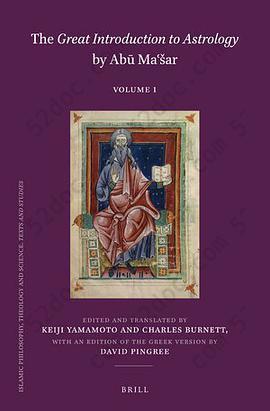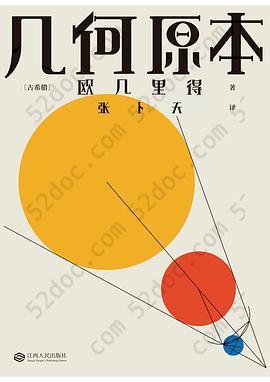该文章不存在或未发布
注重体验与质量的电子书资源下载网站
分类于: 人工智能 设计
简介

The Great Introduction to Astrology by Abū Maʿšar 豆 0.0分
资源最后更新于 2020-09-11 16:47:27
作者:Keiji Yamamoto (ed.)
出版社:Brill
出版日期:2019-01
ISBN:9789004381230
文件格式: pdf
标签: 科学史 伊斯兰 Islam Astronomy Astrology
简介· · · · · ·
Abū Ma’͑šar’s Great Introduction to Astrology (mid-ninth century) is the most comprehensive and influential text on astrology in the Middle Ages. In addition to presenting astrological doctrine, it provides a detailed justification for the validity of astrology and establishes its basis within the natural sciences of the philosophers. These two volumes provide a critical editio...
目录
Preface Acknowledgements
Introduction 1 The Life and Works of Abū Maʿšar 2 The Great Introduction to Astrology 3 The Manuscripts 4 Editorial Principles 5 Bibliography and Abbreviations
Arabic Text and English Translation
Part I 1 On the starting-point of the book and the seven headings 2 On the existence of the science of astrology 3 On the modality of the action of the stars in this world 4 On the forms, ‘natures’ (elements), composition, and ‘natured’ (products of the elements) 5 On giving arguments concerning the confirmation of astrology and the refutation of everyone who claims that the stars’ movements have no power, and they have no indication for the things coming to be in this world 6 On the benefit of the science of astrology, and that foreknowledge of things coming to be in this world from the power of the movements of the stars is very beneficial
Part II 1 On the number of the stars of the sphere which have rapid or slow movement 2 On why twelve constellations are considered more suitable for indication than the other constellations of the sphere 3 On the reason for the number of the signs and that they are twelve, no less and nor more 4 On the arrangement of the ‘natures’ of the signs 5 On why one begins with Aries, not the other signs 6 On the reason for the tropical, fixed, and bicorporeal signs 7 On the knowledge of the quadrants of the sphere 8 On the knowledge of the masculine and feminine signs 9 On the diurnal and nocturnal signs
Part III 1 On the reason for the astrologers’ use of the seven planets in the indication of general things 2 On the definition of ‘astrology’ and ‘astrologer’ 3 On the indication proper to the Sun for moderating atmospheric conditions 4 On the indication proper to the Moon for the ebb and flow 5 On the cause of the ebb and flow 6 On the strength and weakness of the flow 7 That the Moon is the cause of the ebb and flow 8 On the difference between the conditions of the seas 9 On the indication of the Moon for animals, plants, and minerals according to the increase and decrease of its light
Part IV 1 On the natures of the seven planets, swift in motion, according to Ptolemy’s account 2 On the natures of the planets and the benefics and malefics among them, according to the account of most of the astrologers 3 On our refutation of those who claimed that the natures of the planets are known only from their colours 4 On our establishment of finding the benefics and malefics according to the method of the philosophers 5 On knowing which planet is benefic and which is malefic 6 On the difference of the conditions of benefics and malefics, and the change of one of them to the nature of another 7 On the natures of the planets, their change from one nature to another, and the strength or weakness of their nature which is inherent in them 8 On the masculinity and femininity of the planets 9 On the diurnal and nocturnal planets
Part V 1 On the shares of the planets in the signs 2 On the reason for the houses of the planets, according to what some astrologers have claimed 3 On the reason for the houses of the planets, according to what agrees with what Ptolemy says 4 On the reason for the houses of the planets, according to what agrees with what Hermes says from G̣āṯīdīmūn 5 On the reason for the exaltations of the planets, according to what some astrologers have claimed 6 On the reason for the exaltations of the planets, according to what Ptolemy claimed 7 On the reason for the exaltations of the planets, according to what Hermes says 8 On the differences in the terms of the planets and their conditions 9 On the terms of the Egyptians 10 On the terms of Ptolemy 11 On the terms of the Chaldeans 12 On the terms of Asṭraṭū 13 On the terms of the Indians 14 On the lords of the triplicities 15 On the decans and their lords, according to what agrees with what the scholars of Persia, Babylon, and Egypt say 16 On the decans and their lords, according to what the Indians said 17 On the nawbahr of the signs, i.e. a ninth, according to what agrees with what the Indians say 18 On the dodecatemoria of the signs and the lords of each degree of each sign 19 On the masculine and feminine degrees 20 On the bright, dusky, dark, and empty degrees 21 On the wells of the planets in the signs 22 On the degrees increasing good fortune
Part VI 1 On the natures and conditions of the signs, and figures that ascend in their decans 2 On the rising times of the signs on the equator and in the seven climes according to what Theon maintained 3 On the aspecting of the degrees of the sphere 4 On the signs that love each other, that hate each other, that are hostile to each other, that are straight and crooked in rising, and that are obedient and disobedient to each other 5 On the signs that agree with each other in zone, rising-times, power, and path 6 On the signs that agree with each other in natural opposition and sextile, and ⟨those that⟩ do not aspect each other 7 On the signs that agree with each other in quartile 8 On the years, months, days, and hours of the signs 9 On the indications of the signs for every country and region of the earth 10 On the signs indicating motion and rest 11 On the voiced signs, which indicate the nature and conditions of people 12 On the division of the members of the human body among the signs 13 On the signs indicating grace and beauty; the signs indicating generosity and liberality; the signs which are united and filled; those which give wealth; those which pour out; and those which seize and take 14 On the signs indicating lust and diseases 15 On the signs indicating the chastity and virtue of women 16 On the signs having many children, twins, few children, and barrenness 17 On the signs whose members are cut and on the signs having plenty of violence and anger 18 On the signs indicating the conditions of voices 19 On the signs indicating mange, leprosy, spots, itching, head scurf, deafness, dumbness, baldness, thinness of beard, beardlessness, and one who has no beard 20 On the signs indicating faults in the eye 21 On the signs indicating culture, cajolement, deception, and cunning, the signs of worry, and the dark signs 22 On the signs indicating the species of birds, and all quadrupeds, beasts of prey, vermin, insects, and aquatic animals 23 On the signs indicating trees and plants 24 On the signs indicating different kinds of water and the signs indicating what is produced by fire 25 On the directions of the signs 26 On the cardines of the sphere, its quadrants and twelve places, summarizing their indications, and the reason for that 27 On the quadrants of the sphere related to corporality, spirituality, and other things 28 On the mixture of the ‘natures’ of the cardines of the horoscope 29 On the colours of the quadrants of the sphere and of the twelve places 30 On ascending, descending, long, and short quadrants of the sphere 31 On the division of the four ‘natures’ among things 32 On the reason for the quarters of one day and one night and their twenty-four hours 33 On the lords of the days and the hours
Part VII 1 On the conditions of the planets in themselves 2 On the conditions of the planets in respect to the Sun, being in front of it and behind it 3 On the conditions of the planets in respect to the quarters of the sphere and their places, and the range of the power of their bodies 4 On the conjunction of the planets with each other and the mixture of their qualities, and which is strongest and weakest among them 5 On the aspect of the planets to each other and their application and separation, and their other similar conditions that follow that 6 On the good fortune of the planets and their strength, weakness, and bad fortune, and the corruption of the Moon 7 On the casting of the rays of the planets according to Ptolemy’s practice 8 On the knowledge of the years of the fardārs of the planets and their greatest, great, middle, and small years 9 On the natures of the seven planets and their proper indications for existing things
Part VIII 1 On the reason for extracting the lots 2 On the classification of the lots and their names 3 On the lots of the seven planets 4 On the lots of the twelve places 5 On the account of the lots which are not mentioned with the seven planets, nor with the lots of the twelve places 6 On the account of all the lots in summary 7 On the coincidence of the lots in one position 8 On the knowledge of the general indications of the lots 9 On the knowledge of the position of some indications from others
Introduction
Greek Text
Contents
Part I 1 On that power is distributed from the celestial bodies onto the earth 2 On that the Moon has 28 places 3 On that farmers also know the suitable times ⟨of action⟩ 4 On what kind of child the woman gives birth to after the first birth: male or female 5 On that shepherds have signs concerning the birth of domestic animals
Part II 6 On that the figure of the heaven is spherical 7 On the place of the fixed stars and the kind of thing observed from them and from the planets 8 On the reason why they are called fixed, tropical, and bicorporeal signs 9 On the reasons for the masculine and feminine signs
Part III 10 On that the Sun is responsible for generation and corruption 11 On why the Sun was assigned to the middle belt 12 On that the Moon participates with the Sun in generations and corruptions 13 On the actions of the Moon
Part IV 14 On the natures of the seven planets A On natures of the planets and their fortune and misfortune B On their mixture C On the diurnal and nocturnal planets
Part V D On the reason for the planets having lordship over the signs E On exaltations 15 On terms 16 On masculine and feminine degrees 17 On bright, dusky, dark, and empty degrees 18 On fortunate degrees
Part VI 19 On the signs that love or hate each other, are straight-rising and crooked, and are commanding and obeying 20 On the signs that have sympathy for each other, if it happens that they are quartile to each other 21 On the signs rising with each one of decans 22 On the climates assigned to each one of the signs 23 On the signs that move and are at rest 24 On the signs indicating the conditions of men 25 On the signs assigned to each part of the body 26 On the ugly signs, and on the signs showing generosity and large gifts, and those collecting, filling and depleting, those rich and giving and taking 27 On the signs showing desires of love and diseases 28 On the signs showing their judgement and moderation 29 On the signs bearing many children, bearing twins, and being barren 30 On the voiced, half-voiced, and voiceless signs 31 On the signs indicating mange, leprosy, spots, itching, baldness, thin beard, and beardlessness 32 On the signs that bring pains to the eyes and limbs 33 On the signs that deceive, and are subject to sufferings and worries, and the dark signs 34 On the signs indicating birds, quadrupeds, fish, and reptiles 35 On the signs indicating trees and plants 36 On all the watery and fiery signs, and on the indications of the twelve places 37 On the fortunate, incorporeal, corporeal, animate and inanimate signs 38 On the colours of the signs 39 On the ascending and descending signs, and the long and short signs 40 On the cause of those ⟨planets⟩ that preside over and manage ⟨days and hours⟩
Part VII 41 On the condition of the planets 42 On the configuration of the planets toward the Sun 43 On the places of the horoscope in which the planets have strength 44 On the latitude of the planets 45 On the conjunction of the planets 46 On the configurations of the planets 47 On the strength and weakness of the planets 48 On besi
Introduction 1 The Life and Works of Abū Maʿšar 2 The Great Introduction to Astrology 3 The Manuscripts 4 Editorial Principles 5 Bibliography and Abbreviations
Arabic Text and English Translation
Part I 1 On the starting-point of the book and the seven headings 2 On the existence of the science of astrology 3 On the modality of the action of the stars in this world 4 On the forms, ‘natures’ (elements), composition, and ‘natured’ (products of the elements) 5 On giving arguments concerning the confirmation of astrology and the refutation of everyone who claims that the stars’ movements have no power, and they have no indication for the things coming to be in this world 6 On the benefit of the science of astrology, and that foreknowledge of things coming to be in this world from the power of the movements of the stars is very beneficial
Part II 1 On the number of the stars of the sphere which have rapid or slow movement 2 On why twelve constellations are considered more suitable for indication than the other constellations of the sphere 3 On the reason for the number of the signs and that they are twelve, no less and nor more 4 On the arrangement of the ‘natures’ of the signs 5 On why one begins with Aries, not the other signs 6 On the reason for the tropical, fixed, and bicorporeal signs 7 On the knowledge of the quadrants of the sphere 8 On the knowledge of the masculine and feminine signs 9 On the diurnal and nocturnal signs
Part III 1 On the reason for the astrologers’ use of the seven planets in the indication of general things 2 On the definition of ‘astrology’ and ‘astrologer’ 3 On the indication proper to the Sun for moderating atmospheric conditions 4 On the indication proper to the Moon for the ebb and flow 5 On the cause of the ebb and flow 6 On the strength and weakness of the flow 7 That the Moon is the cause of the ebb and flow 8 On the difference between the conditions of the seas 9 On the indication of the Moon for animals, plants, and minerals according to the increase and decrease of its light
Part IV 1 On the natures of the seven planets, swift in motion, according to Ptolemy’s account 2 On the natures of the planets and the benefics and malefics among them, according to the account of most of the astrologers 3 On our refutation of those who claimed that the natures of the planets are known only from their colours 4 On our establishment of finding the benefics and malefics according to the method of the philosophers 5 On knowing which planet is benefic and which is malefic 6 On the difference of the conditions of benefics and malefics, and the change of one of them to the nature of another 7 On the natures of the planets, their change from one nature to another, and the strength or weakness of their nature which is inherent in them 8 On the masculinity and femininity of the planets 9 On the diurnal and nocturnal planets
Part V 1 On the shares of the planets in the signs 2 On the reason for the houses of the planets, according to what some astrologers have claimed 3 On the reason for the houses of the planets, according to what agrees with what Ptolemy says 4 On the reason for the houses of the planets, according to what agrees with what Hermes says from G̣āṯīdīmūn 5 On the reason for the exaltations of the planets, according to what some astrologers have claimed 6 On the reason for the exaltations of the planets, according to what Ptolemy claimed 7 On the reason for the exaltations of the planets, according to what Hermes says 8 On the differences in the terms of the planets and their conditions 9 On the terms of the Egyptians 10 On the terms of Ptolemy 11 On the terms of the Chaldeans 12 On the terms of Asṭraṭū 13 On the terms of the Indians 14 On the lords of the triplicities 15 On the decans and their lords, according to what agrees with what the scholars of Persia, Babylon, and Egypt say 16 On the decans and their lords, according to what the Indians said 17 On the nawbahr of the signs, i.e. a ninth, according to what agrees with what the Indians say 18 On the dodecatemoria of the signs and the lords of each degree of each sign 19 On the masculine and feminine degrees 20 On the bright, dusky, dark, and empty degrees 21 On the wells of the planets in the signs 22 On the degrees increasing good fortune
Part VI 1 On the natures and conditions of the signs, and figures that ascend in their decans 2 On the rising times of the signs on the equator and in the seven climes according to what Theon maintained 3 On the aspecting of the degrees of the sphere 4 On the signs that love each other, that hate each other, that are hostile to each other, that are straight and crooked in rising, and that are obedient and disobedient to each other 5 On the signs that agree with each other in zone, rising-times, power, and path 6 On the signs that agree with each other in natural opposition and sextile, and ⟨those that⟩ do not aspect each other 7 On the signs that agree with each other in quartile 8 On the years, months, days, and hours of the signs 9 On the indications of the signs for every country and region of the earth 10 On the signs indicating motion and rest 11 On the voiced signs, which indicate the nature and conditions of people 12 On the division of the members of the human body among the signs 13 On the signs indicating grace and beauty; the signs indicating generosity and liberality; the signs which are united and filled; those which give wealth; those which pour out; and those which seize and take 14 On the signs indicating lust and diseases 15 On the signs indicating the chastity and virtue of women 16 On the signs having many children, twins, few children, and barrenness 17 On the signs whose members are cut and on the signs having plenty of violence and anger 18 On the signs indicating the conditions of voices 19 On the signs indicating mange, leprosy, spots, itching, head scurf, deafness, dumbness, baldness, thinness of beard, beardlessness, and one who has no beard 20 On the signs indicating faults in the eye 21 On the signs indicating culture, cajolement, deception, and cunning, the signs of worry, and the dark signs 22 On the signs indicating the species of birds, and all quadrupeds, beasts of prey, vermin, insects, and aquatic animals 23 On the signs indicating trees and plants 24 On the signs indicating different kinds of water and the signs indicating what is produced by fire 25 On the directions of the signs 26 On the cardines of the sphere, its quadrants and twelve places, summarizing their indications, and the reason for that 27 On the quadrants of the sphere related to corporality, spirituality, and other things 28 On the mixture of the ‘natures’ of the cardines of the horoscope 29 On the colours of the quadrants of the sphere and of the twelve places 30 On ascending, descending, long, and short quadrants of the sphere 31 On the division of the four ‘natures’ among things 32 On the reason for the quarters of one day and one night and their twenty-four hours 33 On the lords of the days and the hours
Part VII 1 On the conditions of the planets in themselves 2 On the conditions of the planets in respect to the Sun, being in front of it and behind it 3 On the conditions of the planets in respect to the quarters of the sphere and their places, and the range of the power of their bodies 4 On the conjunction of the planets with each other and the mixture of their qualities, and which is strongest and weakest among them 5 On the aspect of the planets to each other and their application and separation, and their other similar conditions that follow that 6 On the good fortune of the planets and their strength, weakness, and bad fortune, and the corruption of the Moon 7 On the casting of the rays of the planets according to Ptolemy’s practice 8 On the knowledge of the years of the fardārs of the planets and their greatest, great, middle, and small years 9 On the natures of the seven planets and their proper indications for existing things
Part VIII 1 On the reason for extracting the lots 2 On the classification of the lots and their names 3 On the lots of the seven planets 4 On the lots of the twelve places 5 On the account of the lots which are not mentioned with the seven planets, nor with the lots of the twelve places 6 On the account of all the lots in summary 7 On the coincidence of the lots in one position 8 On the knowledge of the general indications of the lots 9 On the knowledge of the position of some indications from others
Introduction
Greek Text
Contents
Part I 1 On that power is distributed from the celestial bodies onto the earth 2 On that the Moon has 28 places 3 On that farmers also know the suitable times ⟨of action⟩ 4 On what kind of child the woman gives birth to after the first birth: male or female 5 On that shepherds have signs concerning the birth of domestic animals
Part II 6 On that the figure of the heaven is spherical 7 On the place of the fixed stars and the kind of thing observed from them and from the planets 8 On the reason why they are called fixed, tropical, and bicorporeal signs 9 On the reasons for the masculine and feminine signs
Part III 10 On that the Sun is responsible for generation and corruption 11 On why the Sun was assigned to the middle belt 12 On that the Moon participates with the Sun in generations and corruptions 13 On the actions of the Moon
Part IV 14 On the natures of the seven planets A On natures of the planets and their fortune and misfortune B On their mixture C On the diurnal and nocturnal planets
Part V D On the reason for the planets having lordship over the signs E On exaltations 15 On terms 16 On masculine and feminine degrees 17 On bright, dusky, dark, and empty degrees 18 On fortunate degrees
Part VI 19 On the signs that love or hate each other, are straight-rising and crooked, and are commanding and obeying 20 On the signs that have sympathy for each other, if it happens that they are quartile to each other 21 On the signs rising with each one of decans 22 On the climates assigned to each one of the signs 23 On the signs that move and are at rest 24 On the signs indicating the conditions of men 25 On the signs assigned to each part of the body 26 On the ugly signs, and on the signs showing generosity and large gifts, and those collecting, filling and depleting, those rich and giving and taking 27 On the signs showing desires of love and diseases 28 On the signs showing their judgement and moderation 29 On the signs bearing many children, bearing twins, and being barren 30 On the voiced, half-voiced, and voiceless signs 31 On the signs indicating mange, leprosy, spots, itching, baldness, thin beard, and beardlessness 32 On the signs that bring pains to the eyes and limbs 33 On the signs that deceive, and are subject to sufferings and worries, and the dark signs 34 On the signs indicating birds, quadrupeds, fish, and reptiles 35 On the signs indicating trees and plants 36 On all the watery and fiery signs, and on the indications of the twelve places 37 On the fortunate, incorporeal, corporeal, animate and inanimate signs 38 On the colours of the signs 39 On the ascending and descending signs, and the long and short signs 40 On the cause of those ⟨planets⟩ that preside over and manage ⟨days and hours⟩
Part VII 41 On the condition of the planets 42 On the configuration of the planets toward the Sun 43 On the places of the horoscope in which the planets have strength 44 On the latitude of the planets 45 On the conjunction of the planets 46 On the configurations of the planets 47 On the strength and weakness of the planets 48 On besi








